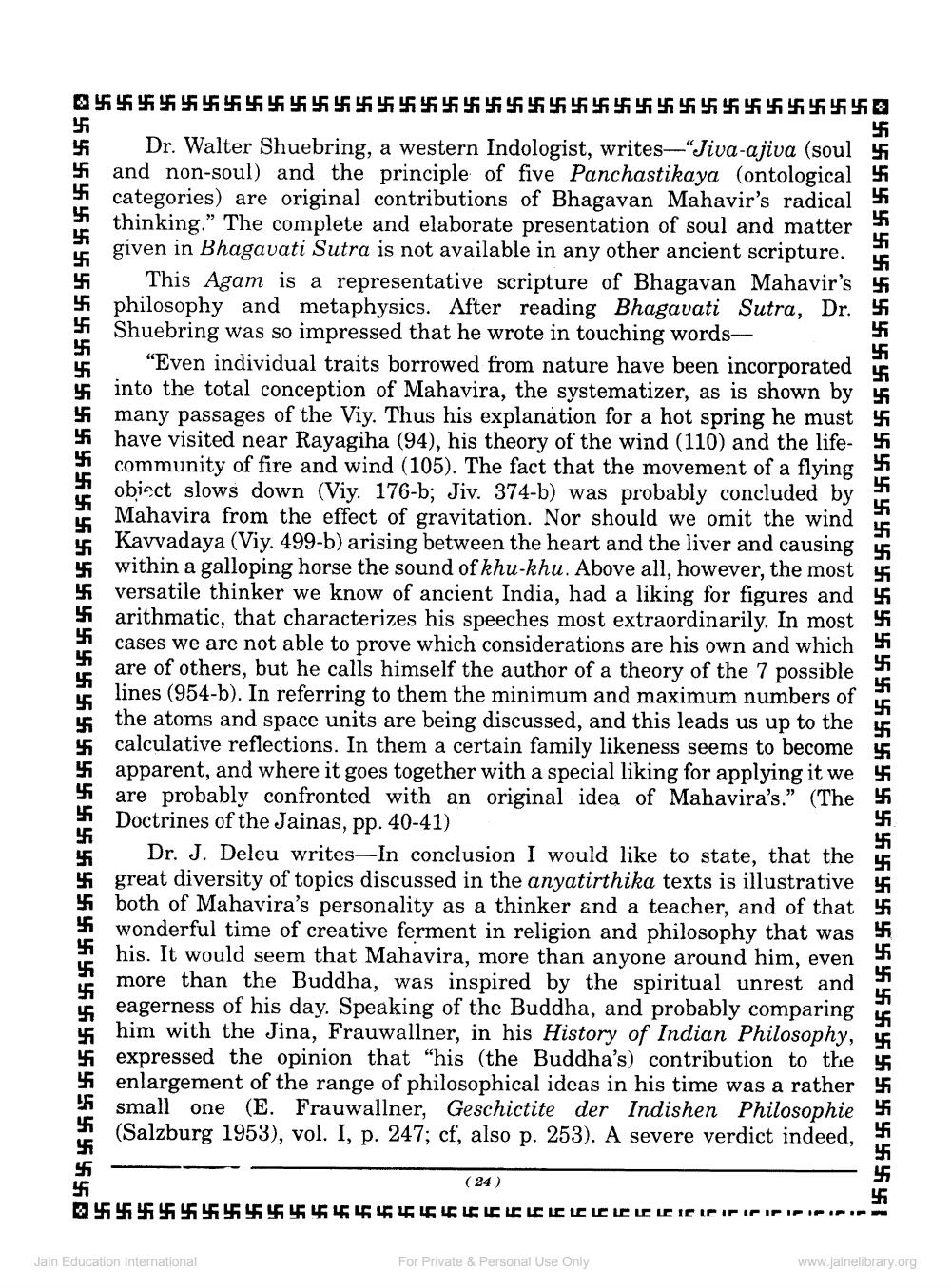________________
$$$ $$1414141414141414141414141414141414141414545454545454545
41 41 41 41 41 41 41 42
455 456 457 45
57 451 454 455 456 457 455 456 457 455 456 455 456 457 455 456
4
45454545454545454545454545454 455 456 457 458 459 41 41 41 41 41 14446 441 414145145
Dr. Walter Shuebring, a western Indologist, writes—"Jiva-ajiva (soul 4 and non-soul) and the principle of five Panchastikaya (ontological categories) are original contributions of Bhagavan Mahavir's radical thinking.” The complete and elaborate presentation of soul and matter given in Bhagavati Sutra is not available in any other ancient scripture.
This Agam is a representative scripture of Bhagavan Mahavir's philosophy and metaphysics. After reading Bhagavati Sutra, Dr. Shuebring was so impressed that he wrote in touching words
“Even individual traits borrowed from nature have been incorporated into the total conception of Mahavira, the systematizer, as is shown by many passages of the Viy. Thus his explanation for a hot spring he must have visited near Rayagiha (94), his theory of the wind (110) and the life- 41 community of fire and wind (105). The fact that the movement of a flying obiect slows down (Viy. 176-b; Jiv. 374-b) was probably concluded by Mahavira from the effect of gravitation. Nor should we omit the wind Kavvadaya (Viy. 499-b) arising between the heart and the liver and causing within a galloping horse the sound of khu-khu. Above all, however, the most versatile thinker we know of ancient India, had a liking for figures and arithmatic, that characterizes his speeches most extraordinarily. In most cases we are not able to prove which considerations are his own and which are of others, but he calls himself the author of a theory of the 7 possible lines (954-b). In referring to them the minimum and maximum numbers of the atoms and space units are being discussed, and this leads us up to the calculative reflections. In them a certain family likeness seems to become apparent, and where it goes together with a special liking for applying it we are probably confronted with an original idea of Mahavira's." (The Doctrines of the Jainas, pp. 40-41)
Dr. J. Deleu writes-In conclusion I would like to state, that the great diversity of topics discussed in the anyatirthika texts is illustrative both of Mahavira's personality as a thinker and a teacher, and of that wonderful time of creative ferment in religion and philosophy that was his. It would seem that Mahavira, more than anyone around him, even more than the Buddha, was inspired by the spiritual unrest and eagerness of his day. Speaking of the Buddha, and probably comparing him with the Jina, Frauwallner, in his History of Indian Philosophy, expressed the opinion that "his (the Buddha's) contribution to the enlargement of the range of philosophical ideas in his time was a rather small one (E. Frauwallner, Geschictite der Indishen Philosophie (Salzburg 1953), vol. I, p. 247; cf, also p. 253). A severe verdict indeed,
456 457 458 459 41 455 456
57 455
455 456 4
4
4
4
4 4
4
4
4 4
( 24 )
4
454 455 456 457 45454545454545454545454 LLLLLLL LL LIPICIT Iriri
Jain Education International
For Private & Personal Use Only
www.jainelibrary.org




